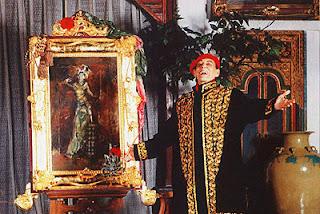Trekking, Cycling and Riding a scooter around Ubud isn’t complete without see the rice fields in Ubud. A very interesting route to follow for trekking, cycling and riding a scooter through the rice fields in Ubud, Bali. Here is the area you might to see in Ubud.
Where to go to see the rice fields in Ubud? From Ubud Market (Jalan Raya Ubud) go to the west direction around 300 meters you will see Abangan Bungalow signboard.
turn right onto the road climbs, follow the street left of the lobby Abangan Bungalow, than entering the small alley to rice fields.
This is a small path maximum can sharing with 2 motorcycles. Just follow the path and enjoy the view of rice fields, you will see Sari Organic restaurant and many new villas are under construction in the rice fields.
 |
| at this point don't turn right, just go straight follow the sign to ubud, taxi |
Drive slowly between the rice fields up to see the main road, turn right to back to Ubud (Map-Orange lane option 1) or continue to left to Kelabang Moding Village, follow the road at Abangan Village turn left follow the road than you will see more rice fields in ubud at T-Junction.
 |
| you will come from right than turn right here |
turn right and you will see another T-Junction turn left to see white heron birds in Petulu Village (Map-Red line option 2)
or follow the road to see another T-junction turn right than turn left to see rice fields in Tegalantang Village. There are many new accommodations along the road (Map-Green line option 3)
or follow the road to Kutuh Village, here you can see some rice fields in ubud and may be want to visit Botanical Garden, in this area there are many villas and house for rent.
Follow the road you will back to Ubud Main Road (Jalan Raya Ubud) turn right to back to Ubud Market.
View Ubud Through Rice Fields in a larger map
Label:
Central Bali,
Cycling,
Trekking,
Ubud,
Ubud Cycling,
Ubud Trekking








































































